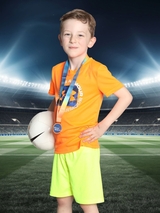A Wavy Line to Wellness: Liam’s Journey
A Wavy Line to Wellness: Liam’s Journey
At 20 week’s gestation, a routine anatomy scan at the University of the Hospital of Pennsylvania (Penn) showed abnormalities in Jenna’s unborn baby’s heart. Suspecting heterotaxy syndrome – a rare birth defect that causes organs in the chest and abdomen to be abnormally arranged or missing – Jenna's care team referred her to the Fetal Heart Program at Children’s Hospital of Philadelphia (CHOP) for further evaluation. It would soon become clear that this would only be the first stop on Liam’s rocky road to wellness.

Jack Rychik, MD, Medical Director of CHOP’s Fetal Heart Program, confirmed the diagnosis. In addition to heterotaxy syndrome, Jenna’s baby had an atrioventricular (AV) canal defect and a high chance of developing biliary atresia (blocked bile ducts).
Jenna was monitored closely throughout her pregnancy, and Liam was delivered in the Center for Fetal Diagnosis and Treatment’s Garbose Family Special Delivery Unit, the world’s first birth facility in a pediatric hospital specifically designed for healthy mothers carrying babies with known birth defects.
“I didn’t think I was going to get to hold him,” Jenna remembers. “But after the team checked him out, I was able to hold him and even let him nurse before they took him to the CICU [Cardiac Intensive Care Unit].”
Liam underwent several tests during his first few days of life to confirm the arrangement of his organs and to monitor the health of his heart and liver.
Though Liam was discharged after five days, doctors would continue to monitor him over the next several weeks for signs of biliary atresia. Blocked bile ducts prevent bile and waste from leaving the body, which can be life-threatening.
After inconclusive imaging and a liver biopsy, Liam underwent a surgical examination of his bile ducts, known as the Kasai procedure. During this procedure, a surgeon removes the diseased bile ducts from the liver and replaces them with a section of the small intestine. This allows bile to drain directly from the liver to the large intestine.
The procedure was successful. “That was the good news,” says Jenna.
The hope we needed

A few months later, Jenna noticed that, even though Liam was nursing, he wasn’t gaining weight. When his breathing became labored, the family’s pediatrician sent them back to CHOP. Liam was in heart failure. He would eventually need heart surgery; however, Dr. Rychik felt that allowing Liam’s heart to grow before surgery would give him the best chance for success.
Liam was placed on medication and given a nasogastric (NG) tube for feeding to prevent further weight loss. “That was a big part of our lives at that time,” says Jenna. “Pumping, adding formula. It was really hard at first, but my husband and I would tag-team. We got really good at all the tips and tricks, and soon we got the feeding process down.”
Dr. Rychik examined Liam monthly, and by the time the baby was 15 months, his heart was ready for surgery.
To help prepare Liam’s 3-year-old brother, Luca, for Liam’s time in the hospital, the family threw a heart party the night before Liam’s surgery. “We had heart-shaped pizza and cookies; we decorated like it was Valentine’s Day,” says Jenna. “Liam was finally getting his heart fixed, and we were all so excited.”
On June 4, 2021, Liam underwent reconstructive heart surgery with Jonathan Chen, MD, Co-Director of CHOP’s Cardiac Center and Chief of the Division of Cardiothoracic Surgery. After a successful operation, “I hugged Dr. Chen,” says Jenna. “My sister and my dad were there. We were hugging each other and jumping up and down. We were just so relieved that his surgery went well. It was the best thing in the world.”
Liam’s recovery, however, would prove much more difficult. The first night after his surgery, Liam experienced a cardiac arrest and was placed on ECMO for nine days. His parents stayed by his side the entire time. “Dr. Chen came in every day to see us,” says Jenna. “He was always such a positive light. He and Dr. Rychik gave us the hope we needed.”
One day before Jenna’s birthday, she was finally able to hold Liam for the first time since his surgery.
She remembers a doctor telling her that recovery isn’t a straight line. “It’s a wavy line with lots of ups and downs, but eventually you get to the same end point.”
That philosophy helped Liam’s parents navigate the continued challenges of his recovery, including the placement of a pacemaker. “It was not an easy road,” Jenna says.
An unsettling discovery
By the end of the summer, Liam was finally able to return home. With the help of physical therapy (PT), the 18-month-old was walking and soon even eating without the NG tube.
Because of his history of biliary atresia, however, Liam was often seen in the ER for fevers so doctors could confirm the continued health of his liver.
During one such visit, the attending hepatologist who evaluated Liam suggested the toddler undergo genetic testing. “She said that when a child has two rare diseases, it is often caused by a genetic condition,” says Jenna.
The results of Liam’s genomic testing confirmed two mutations – the same mutations that cause primary ciliary dyskinesia (PCD). PCD is a rare inherited disorder involving defects in the structure and/or function of cilia, the tiny hair-like structures that move fluids and particles in various parts of the body, including the airways. If there are defects in the cilia lining the airways, the body is unable to expel foreign material and clear mucus. This can lead to pulmonary complications, including frequent infections of the lungs, ears, throat and sinuses.
“That was so hard to hear,” says Jenna. “He had already had so many other challenges.”
World-class care for PCD
Liam was seen by Maureen Josephson, DO, Medical Director of CHOP’s Primary Ciliary Dyskinesia Center. The PCD Center is one of several specialized centers within CHOP's Division of Pulmonary and Sleep Medicine, which is consistently ranked among the top pulmonary programs in the country by U.S. News & World Report. The center provides comprehensive treatment and follow-up care for children with this rare condition.
Since there is no cure for primary ciliary dyskinesia, ongoing care is focused on slowing disease progression by maintaining airway health. Through the PCD Center, Liam’s parents learned how to perform chest and airway clearance therapy at home. This includes an inhaler and nebulizer to loosen mucus, followed by chest physical therapy (pounding on the chest and back) for 20 minutes every morning and evening. “We call it his ‘nebby-tappies,’” says Jenna.
Liam will continue to be followed by Dr. Josephson to monitor the health of his lungs. Now almost 5, Liam loves making new friends, playing with his brother, soccer and swimming. His parents plan for him to start kindergarten this fall.
Despite his traumatic medical history, Liam “doesn’t know what he’s been through,” says Jenna. “He wants to do everything at 100 percent.”